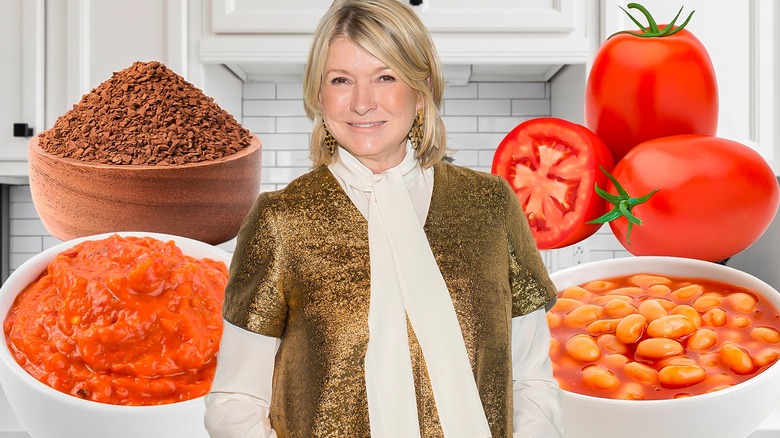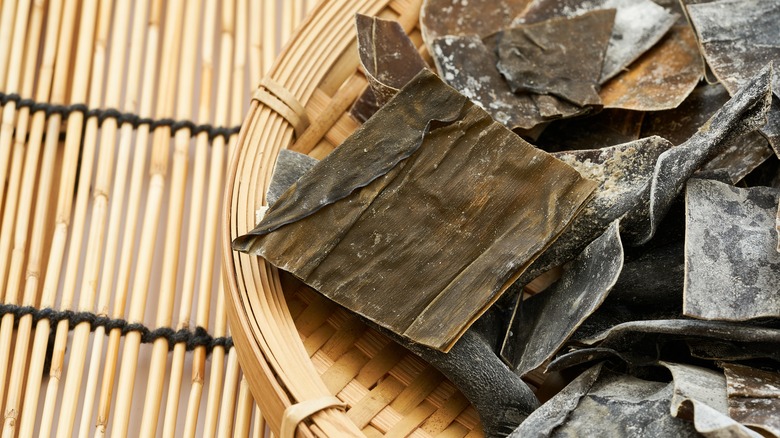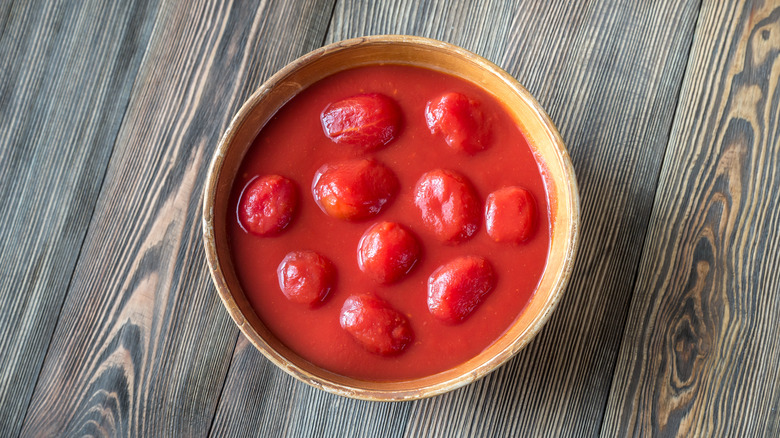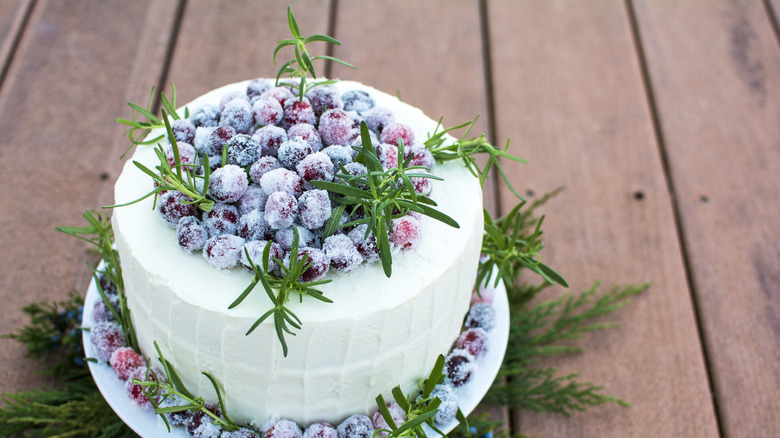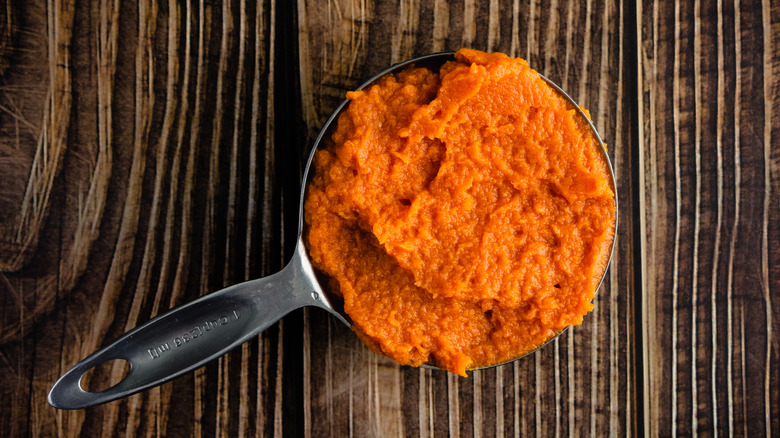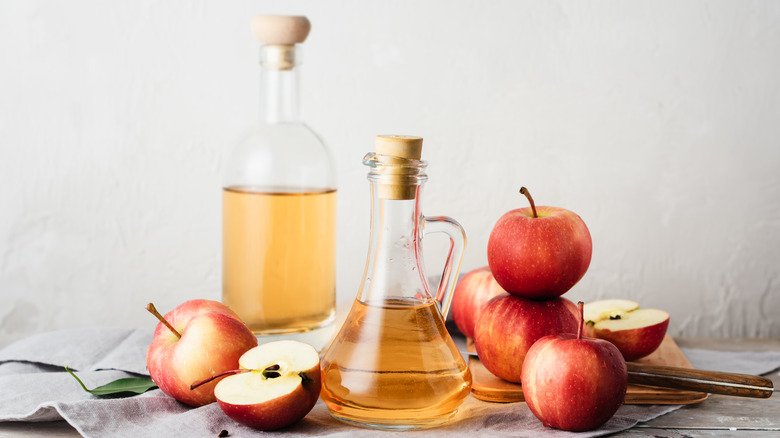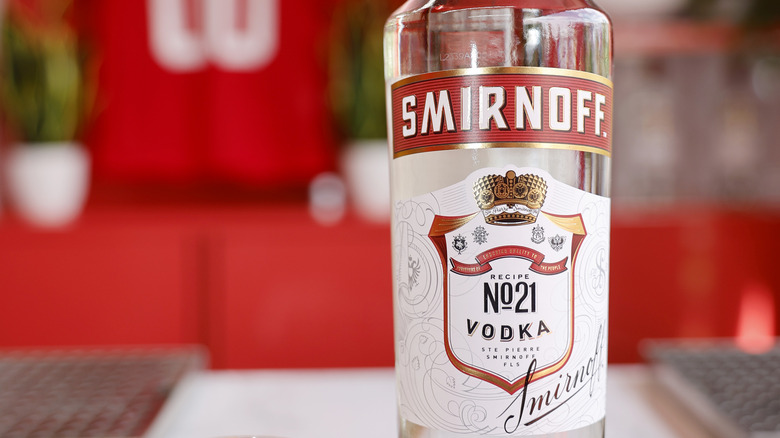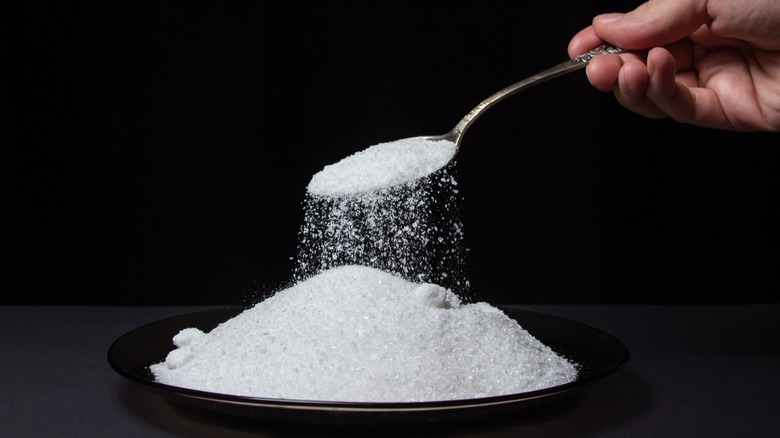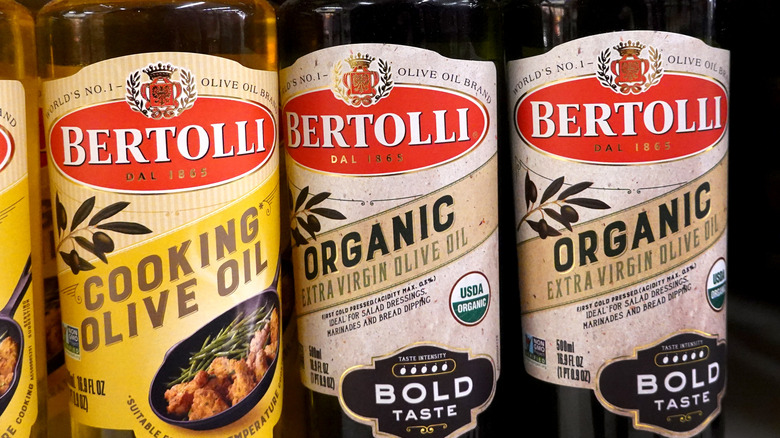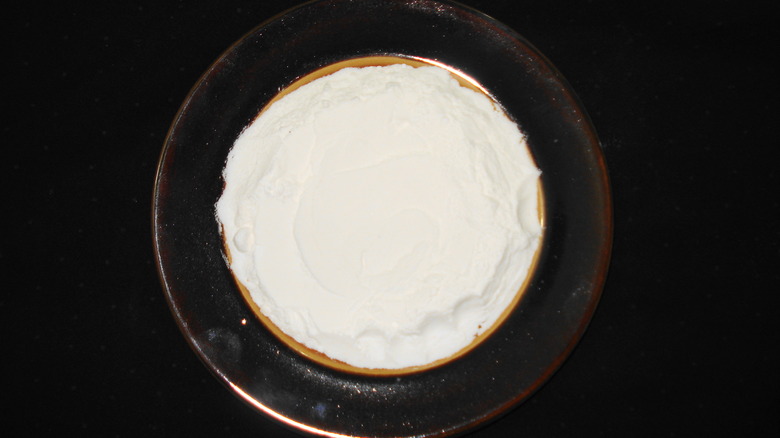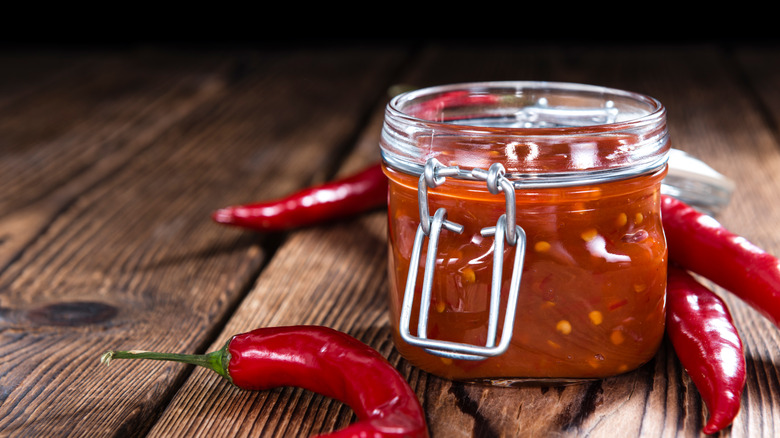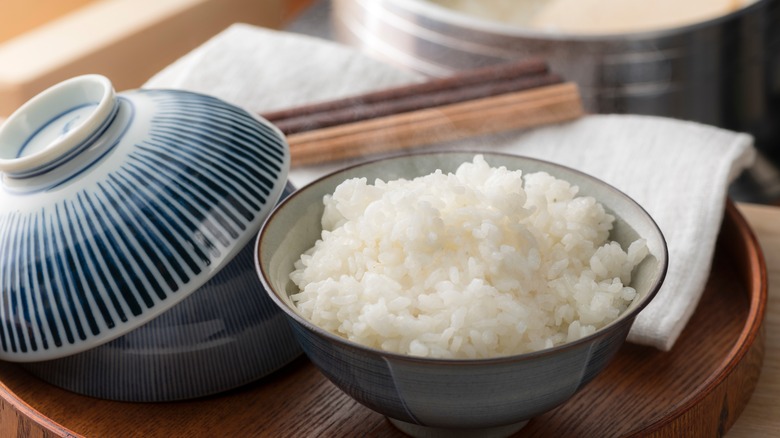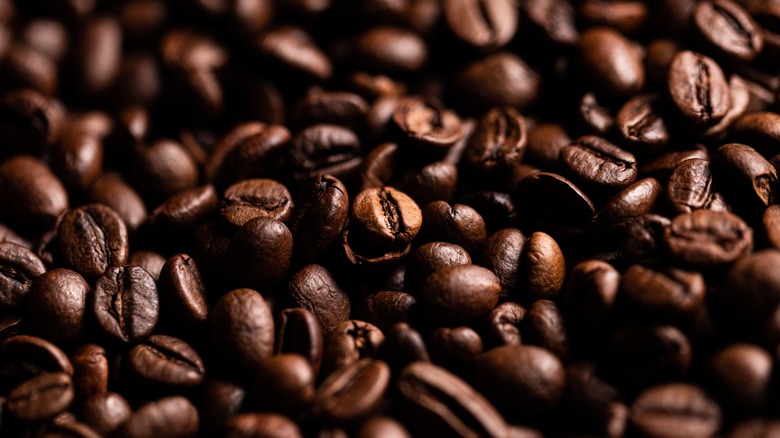13 Essential Items Martha Stewart Keeps In The Pantry
There are many facts you should know about Martha Stewart, as she provides wide-ranging inspiration for all things kitchen and dining, whether you're getting ready to host a 12-person dinner party or just looking for ideas on what to cook for yourself tonight. Whatever plans you have in store, you can be sure that Stewart will provide you with ideas for creating an elegant, creative, and overall high-quality experience.
It's no wonder, then, that Stewart would also be the first person on anyone's list for finding inspiration on how to stock their pantry. That's because we all know her vision transcends the mundane task of food storage; it transforms pantries into artful, functional spaces that reflect a harmonious blend of aesthetics and utility. How does she pull this off, you ask? First of all, with her holistic approach. Stewart seamlessly combines her culinary expertise with a knack for interior design, which can transform each food-pantry item into an element of decor. Second, her penchant for organization ensures every ingredient has its rightful place in the pantry to maximize efficiency. Lastly, her undeniable good taste suggests that anything she has in her pantry is probably something we also need in ours. Let's take a look at what those items are so we can begin our own pantry overhaul.
Foraged seaweed
Not all pantry items need to be store-bought, as many people often assume. After all, there was a time in relatively recent human history when most ingredients weren't store-bought. Indeed, pantries across our nation were filled with home-canned tomatoes, freshly milled flour, farm eggs, and the like. So don't be surprised to find out that Martha Stewart took a page out of the cookbooks of yore and furnished her pantry with some foraged seaweed that she preserved herself. Since she has a home on the beautiful Maine coast, where seaweed grows wild and plentifully, it would be a shame to just leave it there.
But how does it get from the cold Atlantic Ocean to the warm pantry? As she revealed to Food & Wine, Stewart first gathers her seaweed, which in this case is the kombu variety, a kelp that typically grows near the surface off the coast of Maine. She then dries it and turns it into seaweed salt. If you want to try your hand at this advanced culinary action, you'll have to make your way to a cold seacoast, gather up your prime ingredient, and dry it out, either by air-drying it over time or by using a dehydrator or oven. At this point, all you have to do is grind the kelp into a powder along with some flaky salt, such as Maldon.
Canned beans
You can never go wrong when you always have canned beans in your pantry. They're nutritious, last for ages, and when properly cooked, they taste delicious. Not to mention the fact that they come in a wide variety — from black beans to cannellini beans to chickpeas — all of which have their own individual flavor and texture. Indeed, Martha Stewart recommends stocking up on these varieties, plus great northern beans, pinto beans, and kidney beans, all of which can come in handy to spruce up vegetables, meat, and rice dishes.
The key thing to remember is that when it's time to use them, you should always rinse canned beans before pouring them into your pan. That's because that translucent liquid that coats your canned beans — which has helped to preserve them all this time — is mostly made of salt and starch. While these certainly won't kill you, they're not the healthiest things to ingest, and they risk diminishing the flavor and texture of the actual beans. Once that's taken care of, Stewart recommends using those beans for pretty much anything you want. She singles out adding them to hummus, tacos, stews, and chilis, but at the end of the day, it's up to you, and that's part of the beauty of canned beans.
San Marzano tomatoes
There are canned tomatoes, and then there are cans of San Marzano tomatoes — the royalty of the canned tomato world, the gold standard against which all other tomatoes must be measured. So, if you're going to have canned tomatoes in your pantry, why not go for the best of the best? This seems to be what Martha Stewart is thinking when she, too, opts for the San Marzano variety.
Stewart recommends stocking the pantry with canned tomatoes, whether or not you can get a hold of the best. But since we're talking about superlatives here, you may want to use the highest-quality tomato variety out there, which is at once sweet and robust with a perfect balance of acidity and juiciness. By many accounts, these are the San Marzano tomatoes. Luckily, they're widely available: Several top brands are exported from Italy. While the San Marzano tomato variety can also be grown in the U.S., the taste slightly differs from the Italian-grown tomatoes. Either way, using this ingredient in your marinara sauce or any other tomato-based dish will instantly elevate your recipe.
Sparkling sugar
If you do any baking at all, or even if you just drink coffee in the morning, you're likely to have at least a bit of sugar sitting somewhere in your pantry. But Martha Stewart takes this a step further and stocks sparkling sugar in her kitchen. Although this might not be the type of sugar you put in your coffee (or even in your chocolate chip cookies), it does play an important role in the appearance and texture of a wide range of baked goods.
In fact, sparkling sugar (aka sanding sugar) is made up of large crystals processed into heat-resistant translucent grains. These grains are ideal as a topping for muffins — or in Stewart's case, brioche bread pudding — because they retain their shape and crunch despite the heat that surrounds them, extending a shiny patina over your dessert. Because of their translucent color, they make any baked good look like it's shining. Leave it to Martha to go a step beyond the delicious and turn her desserts into something beautiful.
Canned pumpkin
Pumpkin pulp might not be something you have lying around at all times of the year, but now that we're getting into fall, it's time to go to the store and pick up a few cans. At least this is what Martha Stewart seems to have done, since she makes it a point to keep some handy for all of her delicious pumpkin recipes. Her pumpkin pies and pumpkin-spiced desserts are the stuff of legend, but what hasn't been covered quite so much is Martha Stewart's pumpkin grilled cheese sandwich, which we think everyone should learn how to make.
To start, get hold of some plain pumpkin pulp — meaning not something specifically meant for pie fillings — and mix it with Dijon mustard and some salt and pepper. Spread this over sliced bread and top it with grated white cheddar and fresh sage. Brush the outside of the bread with butter, as you should with any grilled cheese, and cook on both sides until golden. This recipe only requires ¼ cup of pumpkin puree, so feel free to use the rest for whatever fall-inspired pumpkin recipe you can think of.
Apple cider vinegar
Martha Stewart keeps many different types of vinegars handy, but she considers apple cider vinegar as a pantry staple. Along with using it for recipes ranging from roasted sausages to vegan chocolate cake, Stewart calls for 2 whole cups of raw, unfiltered apple cider vinegar in her recipe for fire cider tonic, a tangy beverage cited as an herbal folk remedy offering natural health boosts.
Can't find quality raw apple cider vinegar at the store? No problem, Stewart has you covered. In a 2022 episode of "Martha Cooks", she illustrated her love of apples by preparing a series of apple-based recipes, including homemade apple cider, which has many applications beyond simply enjoying the drink. It can be turned into apple cider vinegar, it can be used to make apple cider doughnuts, or, following Stewart's example, it can be the start of an apple cider cocktail made with bourbon and lemon juice.
Vodka
Vodka is usually something we keep in our liquor cabinet rather than our pantry, but it's worth moving that bottle around if the primary purpose of the spirit is for cooking rather than drinking. This seems to be how Martha Stewart prefers to use it, especially when it comes to lobster, as she demonstrated on Facebook in 2018. But this doesn't mean her lobster will taste like vodka. Rather, it's a cooking method that can help home chefs keep the cooked lobster meat tender by helping break down its collagen content.
To use vodka for this purpose, add some to your cooking water and let it do its magic from there. Somewhere along the cooking process, the vodka will evaporate. Just make sure you don't cook the lobster for more than 18 minutes. If you boil it for too long, no amount of vodka will save it from becoming tough, chewy, and basically impossible to swallow.
A variety of salts
Adding salt is a must for many recipes, but a lot of the time, a home chef will just take some table salt and add it to the pan without a second thought. Martha Stewart, of course, is not the average home chef. In fact, she found not one, not two, but 47 different types of salt in her pantry, as she mentioned in an Instagram post.
While she did not go into detail about which types of salt these were, we can only assume that one of them is the seaweed salt Stewart prepares herself from the foraged kombu growing by her house on the coast of Maine. Others may include kosher salt, which Stewart uses to prepare her lemon confit; Maldon salt, which Stewart puts on the rims of her margarita glasses; flaky sea salt, which goes on her bagels as part of her everything bagel seasoning; and chili-flavored salt, which Stewart uses to grace the rims of cocktail glasses when she wants to give a drink a dose of heat.
Olive oil
Every home chef is likely to have some kind of cooking oil on hand, or perhaps two or three. But we know from her Instagram that Martha Stewart may have over 25 different types of olive oil in her pantry at any given time, and that's not including other types of oils she might have, like avocado or sesame. Now, we know from various interviews and articles that none of those oils will be truffle oil, which is a type of oil Stewart absolutely never uses. She revealed during a Today interview that she dislikes truffle oil because it is likely to have been made with artificial flavoring instead of the real stuff, often with an olive oil base.
We also know that she keeps those oils in the pantry because she advises everyone to store them away from the stove to keep them away from the heat, which degrades the quality more quickly. But how did Stewart possibly rack up so many different types of olive oil? We can only surmise that some of her olive oils are flavored with various ingredients, like the result of her simple herb-infused olive oil recipe. We also know, from an interview in Deseret News, that she keeps at least two types of extra virgin olive oils on hand: a low-grade one for cooking, and a fancy one for finishing touches.
Homemade baking powder
Without baking powder, or some kind of riser, your baked goods are doomed to hardness and flatness. There is store-bought baking powder, which is fine, and then there is homemade baking powder, which Martha Stewart espouses, and which is better than the commercial stuff in a number of ways.
First of all, you may have noticed a slight metallic aftertaste in foods made with store-bought baking powder. That's because many baking powder brands contain sodium aluminum sulfate, a flavor that can easily seep into your baked goods, especially if you make the mistake of adding too much. The good news is that all you have to do to make your own baking powder is combine baking soda with cream of tartar and sometimes cornstarch. And the even better news is that this concoction will provide much better flavor than what the store-bought stuff provides, making your baked goods taste the way the recipe intended. Store your mixture in a sealed container in your pantry for up to six weeks.
Sambal oelek
Martha Stewart loves a bit of spice sometimes, and from what we can tell, one item she likes to reach for when she's in the mood for something hot is sambal oelek, an Asian chili paste that contains fresh red chili peppers, vinegar, and salt. Indeed, Stewart uses it in varied recipes to great effect, including in Vietnamese pho, a spicy chili dip, grilled shrimp, and a chili-and-cucumber margarita.
In fact, the best thing about having a jar of this good stuff on hand is that you can stir it into practically any dish to instantly increase the spice level. It can easily be mixed into mac and cheese to give this all-time favorite an even level of spice, or you can spread it on bread to give your sandwich a surprise kick. But one of our favorite ways to use sambal oelek is how Stewart incorporates it in her extra-special sauce for burgers, along with ketchup, mayonnaise, and pickle juice.
Rice
Much like pasta, rice is a starch that you can add to dishes to make them more filling, or use to create a complete meal along with a protein and a vegetable. So if you have rice on hand, you'll be all set for many types of meals. But you can make rice even more effective by following Martha Stewart's advice for perfect rice that she shared with Insider, which varies somewhat depending on whether you're using white or brown rice.
While many of us boil or steam our rice with nothing but water and salt, this results in a fairly bland dish, albeit one that can be paired with any sauce of your choosing. But rice doesn't have to be bland. Stewart enlivens her rice by first sautéing onions and shallots in olive oil before adding the rice in the pan to sauté it with the mixture. Then she gradually adds already-boiling water, which should be at a ratio of 2 cups for each cup of white rice.
When cooking with brown rice, Stewart says it's best to only use 1¼ cups of water per cup of long-grain brown rice, and 1½ cups of water per cup of short-grain brown rice. Whichever rice you choose, just remember that before cooking it, rinsing rice is more crucial than you might think. This removes starchy rice dust and varied contaminants that likely accumulated on your rice as it made its way from the paddy to your pantry.
Tea and coffee
Tea and coffee can both be used as ingredients in baking, and even in cooking. But sometimes it's nice to have a good cup of something hot just to help us start the day on the right foot. Indeed, this seems to be the main reason why Martha Stewart has tea and coffee in her pantry. In a 2015 interview with Epicurious, Stewart said she has "thousands of teas," and that she's "always trying tea." So, it's probably safe to say that tea is a permanent presence in her pantry.
In the same interview, she also explained that ever since a Damascene moment at just 19 years old, when trying cappuccino for the first time at a café in Rome, she has loved this frothy coffee concoction — she makes cappuccinos for herself and her staff every morning. As such, we can only assume that her pantry is stocked with some of the finest coffee beans or grinds money can buy.
